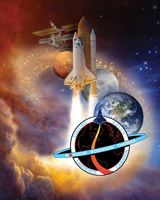Happy Sunday to All.
 The last two days have gone great. Early yesterday, it was terrific to hear the soft “whoosh” sound as Discovery was unlatched from the Space Station and the maneuvering jets (that was the sound) fired softly to push it away from the Station. They backed away 400 feet and then with Jim Kelly on the control stick, Discovery once again (as on STS-102 in 2001) performed a fly around of the Station before beginning its departure from the neighborhood of the Station. Once again, it was exciting to hear Jim’s voice as the maneuver was performed.
The last two days have gone great. Early yesterday, it was terrific to hear the soft “whoosh” sound as Discovery was unlatched from the Space Station and the maneuvering jets (that was the sound) fired softly to push it away from the Station. They backed away 400 feet and then with Jim Kelly on the control stick, Discovery once again (as on STS-102 in 2001) performed a fly around of the Station before beginning its departure from the neighborhood of the Station. Once again, it was exciting to hear Jim’s voice as the maneuver was performed.
Today Vegas and Eileen Collins performed a checkout of Discovery’s flight control systems in advance of tomorrow’s planned de-orbit burn, re-entry and landing at Kennedy Space Center before dawn. Eileen and Vegas also spent time today practicing landings on the Orbiter simulator programmed into Discovery’s computers. Practice, practice, practice! Jim has described the process of de-orbiting from 17,500 mph to resting on the runway as being aboard a runaway train. One way to think about it is to recognize that all the energy that was put into the spacecraft to take it from sitting on the launch pad to orbiting the Earth at 17,500 mph came from the fuel in the External Tank and the solid rocket motors. All that energy must now be removed during the re-entry and landing phase. Most of it is removed through the heating phase of re-entry. When they’re on the runway and the wheels are chocked tomorrow, then the flight is over.
The other crew members primarily spent today stowing gear and packing for tomorrow’s re-entry. All systems are a “go” for tomorrow. The STS-114 crew is sleeping now.
I plan to hit the sack early tonight (around 9 p.m. CDT) in order to wake up at 3 a.m. for the re-entry and landing. One of the changes that NASA implemented in the wake of the Columbia tragedy is to modify the flight path during re-entry away from flying over populated areas as much as possible. The ground track tomorrow will be over Central America and then the Gulf of Mexico before crossing the Florida peninsula on the way to KSC. That means that there will not be an opportunity to see Discovery from Tuscaloosa tomorrow morning as it approaches Florida from the southwest. But, if the sky is clear, there will be a good viewing opportunity to see the ISS between 5:08 and 5:13 a.m. tomorrow. Go to the web site www.heavens-above.com for details. You can check for viewing opportunities no matter where you are. This website is maintained by a group of scientists and software developers in Germany and is free, although you do have to register to access it. I’ve used this site frequently for at least 5-6 years now. Check it out.
Also, a few people have inquired about the courses that Vegas took at UA as part of his master’s in aerospace engineering degree. The best that I remember and who taught the course:
- Compressible Aerodynamics – Dr. Kevin Whitaker
- Flight Dynamics – Dr. Krishna Kumar (now works at NASA Ames Research Center)
- Advance Flight Dynamics – Dr. Amnon Katz (deceased)
- Finite Element Methods – Dr. John Jackson
- Two Math classes – Dr. Chuck Karr
- Advanced Aerodynamics – Dr. Mike Freeman
- Orbital Mechanics I – Dr. Mike Freeman
- Orbital Mechanics II – Dr. Mike Freeman
- 6 hours credit for the academic part of U.S. Air Force Test Pilot School
If I have mis-remembered some of the above details, my apologies to all, but I was relying on what has become a very faulty memory!
On a personal note, Vegas and I have off and on for a year now been discussing getting together to go to a major league baseball game. Nancy and I try to go to 3-4 games each summer in different ballparks. Earlier this summer, we caught games in both Philadelphia and Baltimore. The Kellys are also fans, so when it’s convenient for both families, Nancy and I plan to fly to Houston to visit the Kellys and take in an Astros game. If not this season, then next season.
More on Monday, 8 August…
– – – – – – – – – – – – – –
RELEVANT LINKS:
EDITOR’S NOTE: Dr. Michael Freeman is an Associate Professor of aerospace engineering and mechanics at The University of Alabama. He is attending this week’s launch of the space shuttle Discovery, and will publish daily accounts of the events surrounding the shuttle’s “return to flight” launch. UA graduate James Kelly is the pilot of STS-114, NASA’s first space flight in over two years. Dr. Freeman may be reached by e-mail at michael.freeman@ua.edu.